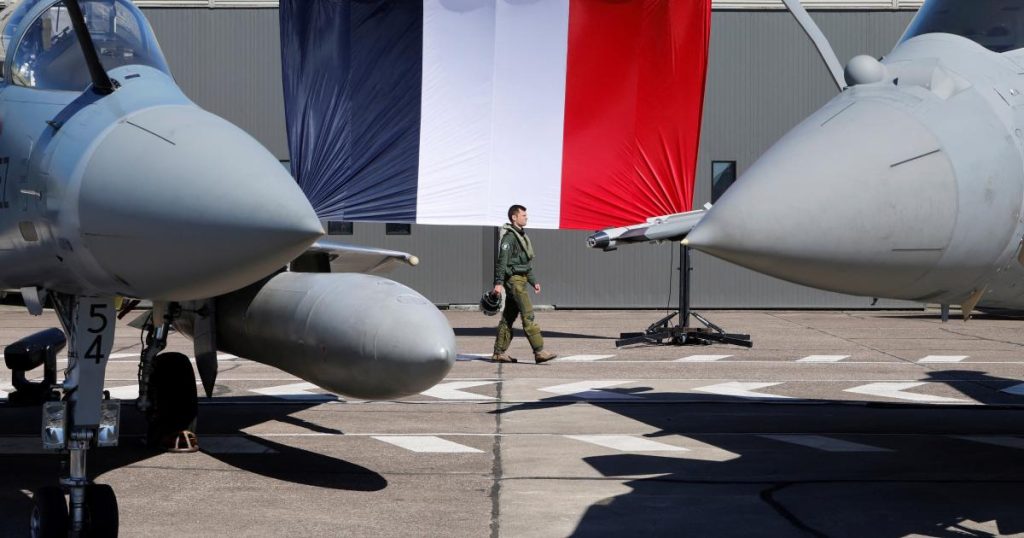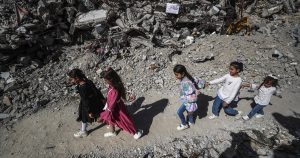
Over the first months of Donald Trump’s presidency, it has become increasingly clear to European leaders that remaining reliant on the United States to underwrite the continent’s security would be a dangerous gamble. Trump’s overtures to Russian President Vladimir Putin, Vice President JD Vance’s public attacks on the domestic policies of European countries, the administration’s imposition of tariffs, and threats to the Danish territory of Greenland have pushed European leaders to begin to think seriously about a future in which the United States—and its nuclear weapons—are no longer the ultimate guarantor of European security.
Skepticism about the United States’ willingness to fight a nuclear war on Europe’s behalf long predates Trump. During the Cold War, French President Charles de Gaulle famously questioned whether the United States would “trade New York for Paris.” But the Trump administration’s hostility has given new urgency to Europe’s efforts to provide for its own defense.
Nonetheless, for Europe to assume responsibility for its own security is not simply a matter of generating more political will, higher defense budgets, or better coordinated procurement processes. Europe must navigate a strategic trilemma regarding its nuclear options. European leaders have three goals they would like to achieve: credible and effective deterrence against Russia; strategic stability, understood as lower incentives for any state to be the first to use a nuclear weapon; and nonproliferation of nuclear weapons to new states. Unfortunately, Europe cannot achieve them all. In fact, choosing any two makes the third impossible. If Europe chooses strategic stability and nonproliferation, it may not be able to deter Russia. But to fortify its nuclear posture enough for credible deterrence, Europe must either allow new states to acquire the weapons or sacrifice a degree of strategic stability. None of the available choices are ideal. But in the absence of protection from across the Atlantic, Europe would be best served by choosing nonproliferation and credible deterrence. Accepting a level of strategic instability in Europe-Russian relations requires assuming genuine nuclear risks. The alternatives, however, would be even more dangerous.
PICK YOUR BATTLE
Europe’s first option in the absence of U.S. protection would be to choose a combination of nonproliferation and strategic stability. This would most closely resemble Europe’s current arrangement, albeit without the United States’ commitments. In this scenario, France and the United Kingdom would remain Europe’s only nuclear-armed powers, and no other countries would acquire nuclear weapons. Europe’s two nuclear powers would continue to maintain arsenals primarily dedicated to providing a reliable second-strike capability, rather than offering extensive first-use options.
But in this scenario, Europe’s defense posture against Russia would lack credibility. NATO frontline countries, particularly the Baltic states, are vulnerable to limited Russian incursions. Russia could then hold any territory it acquired by threatening nuclear action against Europe, a tactic known as “aggressive sanctuarization.” Any Russian threats in such a context would be credible, given Russia’s overwhelming advantage over France and the United Kingdom at the substrategic level—nuclear weapons with smaller yields and shorter reach, designed for battlefield use rather than to threaten total annihilation—in terms of both the scale and the diversity of its arsenal. Moscow could deploy such threats of limited nuclear use with the expectation that Europe’s nuclear powers, without the capacity to respond in kind and thus keep the conflict contained, would back down from trying to recover lost territory. In other words, without the U.S. nuclear backstop, picking nonproliferation and strategic stability would come at the expense of Europe’s deterrence credibility.
Moreover, this credibility gap is unlikely to be bridged by an increase in European conventional forces, at least not in the near future. Avoiding the dilemma of either yielding to Russian nuclear threats and allowing the loss of NATO territory or risking nuclear escalation in attempting to liberate NATO territory would require conventional defenses capable of halting a Russian incursion at the border. European NATO members, particularly those near Russia, have made significant investments in strengthening their local defenses, including through defense spending increases and plans for deploying troops to frontline countries. But these measures are likely still insufficient to immediately repel a determined Russian attack, especially in the Baltics. A defense force that could do more than simply delaying a Russian assault would involve a substantial increase in troops and a posture comparable in scope and ambition to U.S. forces stationed in West Germany during the Cold War. In principle, such an effort is not impossible, but it would take time and sustained investment, well beyond European countries’ latest short-term increases in defense budgets. Realistically, a credible forward defense posture would likely take seven to ten years—or longer—to establish. And even if leaders could marshal the political will, patience, and funding to scale up defense budgets, the continent’s limited production capacity for key military equipment, combined with manpower constraints in several countries, would pose significant obstacles to rapidly building up forces.
Seeking another way to defend itself, Europe could choose nonproliferation and credible deterrence. As in the first scenario, France and the United Kingdom would remain Europe’s only nuclear-armed powers. But to compensate for the gap in conventional capabilities and lower-yield nuclear weapons, Europe would have to rely on extended deterrence provided by its two nuclear states. To deter a Russian attack on frontline states in eastern Europe, however, France and the United Kingdom would need to expand their low-yield, tactical-level nuclear options, and indicate a willingness to use them, including by employing them first. Like the approach taken up by United States and NATO during the Cold War once the Soviet Union gained the ability to hit the United States with nuclear weapons, London and Paris would need to build up their limited nuclear options and develop doctrines that both outline their realistic use in battlefield missions and detail how to manage escalation.
Prioritizing nonproliferation and deterrence would thus require abandoning strategic stability. France and the United Kingdom would need to make the possibility of nuclear first use credible, which would necessarily be perceived as threatening by any potential target of such nuclear use. The chance that a crisis could escalate above the nuclear threshold would rise. Indeed, making crises more prone to nuclear escalation in order to deter Russia from initiating them would be the entire purpose of an updated British and French posture.
The final option for Europe in the absence of U.S. security guarantees would be to choose credible deterrence and strategic stability, sacrificing the continent’s commitment to nonproliferation. In this scenario, Europe’s nuclear powers would retain nuclear arsenals optimized for retaliation rather than first use, thus maintaining strategic stability. But if a nuclear posture geared toward retaliation is to offer credible deterrence against Russian conventional or limited nuclear threats, the weapons need to be under the control of states for which Russian military action would pose an existential threat, not just France and the United Kingdom, which, by virtue of their distance from Russia, do not face the same risk as those on the frontline. Because neither country’s existence would be in danger, their ability to credibly threaten a nuclear response would be limited. For the eastern European country targeted, however, a Russian conventional or nuclear attack would constitute an immediate and existential threat, and Moscow would have to fear that country would use its nuclear weapons, if it had them. In other words, maintaining both credible deterrence and strategic stability requires proliferation: eastern European countries would need to have their own nuclear arsenals to deter Russia from attacking.
FINDING UNSTABLE GROUND
Allowing proliferation in Europe by choosing strategic stability and credible deterrence would be highly costly, however, making it the least attractive of the three options. European states acquiring nuclear weapons could well deal a deathblow to the Nonproliferation Treaty, an international accord that took effect in 1970, and the global effort to stop the spread of these weapons. Moreover, proliferation is an arduous and dangerous process. It would be logistically difficult for countries such as Poland to acquire nuclear capabilities quickly because they lack suitable civilian nuclear infrastructure to divert to a nuclear weapons program. The proliferation process would therefore involve a long period of instability, as Russia would have an incentive to take preventive military action to stop frontline European states acquiring the weapons to deter it.
Forgoing credible deterrence against Russia by choosing strategic stability and nonproliferation might be the most politically expedient choice for European leaders, since it would not require major shifts in doctrine or investments in defense. If European leaders defer their decision on the future of the continent’s nuclear policy (or find themselves caught off-guard by an abrupt but now plausible U.S. departure from Europe), they might have no other choice but to accept this trade. But making the easiest decision would still be a dangerous gamble. Europe would have to hope that Russia would not call its bluff by seizing European territory with conventional forces and nuclear threats, either for the sake of Putin’s expansionist ambitions or to attempt to shatter the NATO alliance once and for all. Western European leaders would also be betting that their vulnerable eastern European counterparts would not seek their own nuclear weapons to protect themselves, which would trigger all the disadvantages and costs associated with proliferation.
The danger in sacrificing credible deterrence is that Europe would be left relying on Russian restraint, a potentially catastrophic choice given Moscow’s track record of invading its neighbors. As a result, some version of British or French extended nuclear deterrence may ultimately prove most attractive. It would provide a plausible path to deterrence without the political costs and security risks of proliferation, and could be put into place relatively quickly if Paris and London are willing to act decisively. The associated costs would be manageable, particularly when compared to the hundreds of billions currently allocated to Europe’s conventional rearmament. Although the risk of a nuclear first strike Europe would increase, it would remain containable, especially if France and Britain developed new doctrines that signaled their resolve below the threshold of nuclear use. Just as in the Cold War, when Washington decided to include its allies under the U.S. nuclear umbrella rather than allow them all to nuclearize or leave them to fend for themselves, extended deterrence looks a better bet than the alternatives.
Europe has no way out of its strategic trilemma that does not involve painful tradeoffs.
Still, relying on Europe’s two nuclear powers to fill the void left by the United States is not an easy task. Neither country’s nuclear arsenal is currently positioned to assume the full array of functions that U.S. nuclear forces provide. In the event of nuclear war with Russia, France and the United Kingdom would be unable to minimize the damage to Europe. They can offer retaliation on a European country’s behalf, but not preemptive action that could head off a strike on European cities and populations. With limited arsenals, particularly when it comes to low-yield weapons that can be used to push Russia back rather than escalate, they also lack the flexibility to counter Russian threats that fall below the level of total annihilation. Both countries have relied on ambiguity in their nuclear strategies, avoiding rigid commitments on the exact conditions of nuclear weapons use to keep adversaries uncertain. This approach may have been effective when their arsenals were solely focused on homeland defense, but it is unlikely to reassure allies that would depend on these nuclear forces for their defense.
Making a strategy of European extended deterrence work will require significant updates to both nuclear hardware and doctrines. Amending their doctrines would be a comparatively quick process. British and French leaders could at any point publicly declare that they are prepared to prevent the conventional defeat of their eastern European allies, even if it requires being the first party to introduce nuclear weapons into a conflict. But France and the United Kingdom would need to increase the scale and diversity of their nuclear arsenals, likely a multiyear undertaking even for France, which has preserved much of the necessary infrastructure. Leaders would also have to sell this strategy at home—which may prove difficult, especially in France. Marine Le Pen, leader of the opposition National Rally party, has already stated her opposition to a French nuclear umbrella and could reverse any changes if she came to power in the country’s 2027 presidential election.
If London and Paris can overcome these hurdles, offering effective extended deterrence to vulnerable eastern European countries may be feasible. The version of extended deterrence they could offer would still be riskier and more fragile than what the United States has offered since the early days of the Cold War. But ultimately, Europe has no way out of its strategic trilemma that does not involve painful tradeoffs. It is therefore no surprise that European leaders have thus far avoided making plans for the continent’s post-American defense. Yet with the future of the continent at stake, Europe is better off acting than not, even if that means accepting the costs associated with the least-bad option.
Loading…








